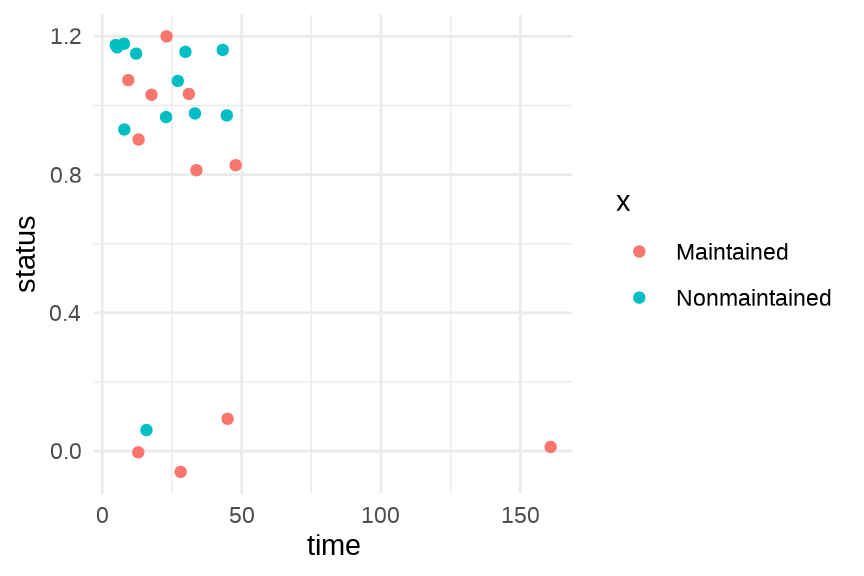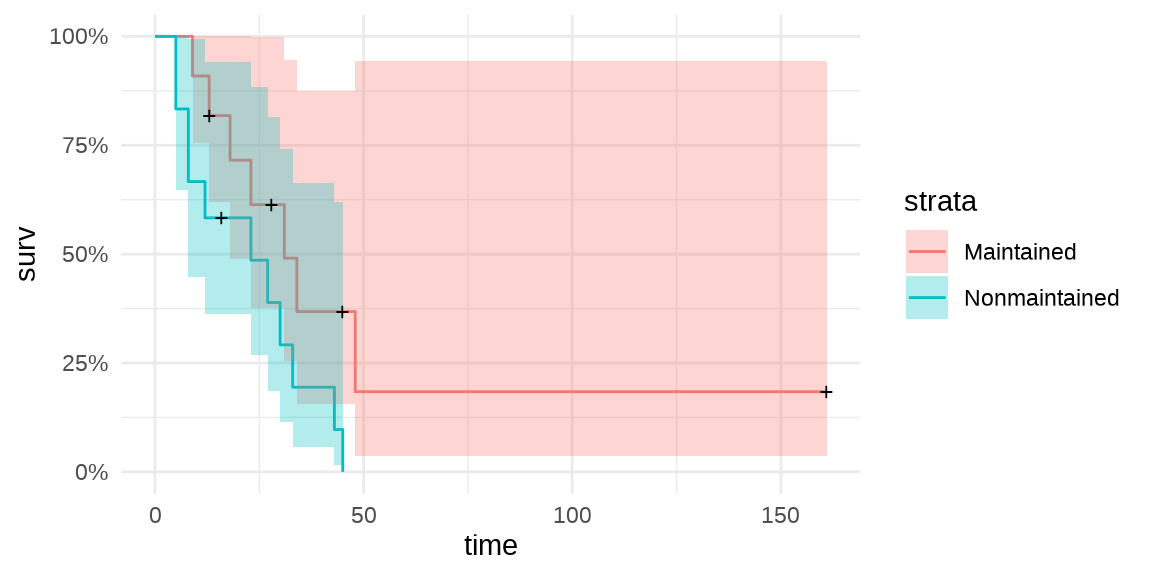25 生存分析
The fact that some people murder doesn’t mean we should copy them. And murdering data, though not as serious, should also be avoided.
— Frank E. Harrell 1
生存分析可以用于用户流失分析,注册、激活、活跃。 分析次日留存、7日留存、15日留存。有学生来上体验课,多久来付费上课。 有一个人医院看病之后,多久办理住院。 最早,生存分析用于研究飞机出去之后,有多少返回的。还是要回归到原始文献去了解基本概念,及其背后的思考和应用
以一个问题提出本章主题,讲述和展示一个数据集。建立模型,拟合模型,结果解释。
25.1 问题背景
急性粒细胞白血病生存数据
'data.frame': 23 obs. of 3 variables:
$ time : num 9 13 13 18 23 28 31 34 45 48 ...
$ status: num 1 1 0 1 1 0 1 1 0 1 ...
$ x : Factor w/ 2 levels "Maintained","Nonmaintained": 1 1 1 1 1 1 1 1 1 1 ...数据的分布情况如下
在垂直方向添加了抖动,不影响时间项 time ,可以对数据的分布看得更加清楚。
25.2 模型拟合
Cox 比例风险回归模型与 Box-Cox 变换 (Box 和 Cox 1964)
-
survival::coxph()Cox 比例风险回归模型 -
MASS::boxcox()Box-Cox 变换 glmnet::glmnet(family = "cox")- INLA 包的函数
inla()与inla.surv()一起拟合,链接 - survstan Stan 与生存分析
- rstanarm 包的函数
stan_jm()使用说明 Estimating Joint Models for Longitudinal and Time-to-Event Data with rstanarm 链接 - rstanarm 包的生存分析分支
25.2.1 survival
R 软件内置了 survival 包,它是实现生存分析的核心 R 包 (Terry M. Therneau 和 Patricia M. Grambsch 2000),其函数 survfit() 拟合模型。
Call: survfit(formula = Surv(time, status) ~ x, data = aml)
x=Maintained
time n.risk n.event survival std.err lower 95% CI upper 95% CI
9 11 1 0.909 0.0867 0.7541 1.000
13 10 1 0.818 0.1163 0.6192 1.000
18 8 1 0.716 0.1397 0.4884 1.000
23 7 1 0.614 0.1526 0.3769 0.999
31 5 1 0.491 0.1642 0.2549 0.946
34 4 1 0.368 0.1627 0.1549 0.875
48 2 1 0.184 0.1535 0.0359 0.944
x=Nonmaintained
time n.risk n.event survival std.err lower 95% CI upper 95% CI
5 12 2 0.8333 0.1076 0.6470 1.000
8 10 2 0.6667 0.1361 0.4468 0.995
12 8 1 0.5833 0.1423 0.3616 0.941
23 6 1 0.4861 0.1481 0.2675 0.883
27 5 1 0.3889 0.1470 0.1854 0.816
30 4 1 0.2917 0.1387 0.1148 0.741
33 3 1 0.1944 0.1219 0.0569 0.664
43 2 1 0.0972 0.0919 0.0153 0.620
45 1 1 0.0000 NaN NA NA拟合 Cox 比例风险回归模型(Cox Proportional Hazards Regression Model)
Call:
coxph(formula = Surv(time, status) ~ 1 + x, data = aml)
n= 23, number of events= 18
coef exp(coef) se(coef) z Pr(>|z|)
xNonmaintained 0.9155 2.4981 0.5119 1.788 0.0737 .
---
Signif. codes: 0 '***' 0.001 '**' 0.01 '*' 0.05 '.' 0.1 ' ' 1
exp(coef) exp(-coef) lower .95 upper .95
xNonmaintained 2.498 0.4003 0.9159 6.813
Concordance= 0.619 (se = 0.063 )
Likelihood ratio test= 3.38 on 1 df, p=0.07
Wald test = 3.2 on 1 df, p=0.07
Score (logrank) test = 3.42 on 1 df, p=0.06展示拟合结果。可以绘制生存分析的图的 R 包有很多,比如 ggfortify 包、ggsurvfit 包和 survminer 包等。ggfortify 包可以直接针对函数 survfit() 的返回对象绘图,ggsurvfit 包提供新函数 survfit2() 拟合模型、函数 ggsurvfit() 绘制图形,画面内容更加丰富,而 survminer 包依赖很多。
参数化的生存分析模型(参数模型,相对于非参数模型而言)
Call:
survreg(formula = Surv(time, status) ~ x, data = aml, dist = "weibull")
Value Std. Error z p
(Intercept) 4.109 0.300 13.70 <2e-16
xNonmaintained -0.929 0.383 -2.43 0.015
Log(scale) -0.235 0.178 -1.32 0.188
Scale= 0.791
Weibull distribution
Loglik(model)= -80.5 Loglik(intercept only)= -83.2
Chisq= 5.31 on 1 degrees of freedom, p= 0.021
Number of Newton-Raphson Iterations: 5
n= 23 下面 ggsurvfit 包再次拟合模型,并展示模型结果。
25.2.2 ggsurvfit
拟合模型需要函数 survfit2()
模型输出
Call: survfit(formula = Surv(time, status) ~ x, data = aml)
n events median 0.95LCL 0.95UCL
x=Maintained 11 7 31 18 NA
x=Nonmaintained 12 11 23 8 NA25.2.3 glmnet
glmnet 包拟合 Cox 比例风险回归模型 (Simon 等 2011) 适合需要多变量筛选的情况。
25.2.4 INLA
INLA 包拟合 Cox 比例风险回归模型 (Gómez-Rubio 2020) 采用近似贝叶斯推断。
library(INLA)
inla.setOption(short.summary = TRUE)
aml_inla <- inla(inla.surv(time, status) ~ x, data = aml, family = "exponential.surv", num.threads = "1:1")
summary(aml_inla)Fixed effects:
mean sd 0.025quant 0.5quant 0.975quant mode kld
(Intercept) -4.173 0.378 -4.913 -4.173 -3.432 -4.173 0
xNonmaintained 0.984 0.483 0.036 0.984 1.931 0.984 0
is computed 25.3 Tobit 回归
Tobit (Tobin’s Probit) regression 起源于计量经济学中的 Tobit 模型,James Tobin 提出的,用于截尾数据,生存分析中的一种加速失效模型 (accelerated failure model) (Tobin 1958)。
- 逻辑回归,响应变量是无序的分类变量,假定服从二项、多项分布,拟合函数
glm()和nnet::multinom() - Probit 回归,响应变量是有序的分类变量,拟合函数
MASS::polr() - Tobit 回归,响应变量是有删失/截尾的,VGAM 包依赖少,稳定,推荐使用。VGAM 包括了广义线性模型
time status
[1,] 9 1
[2,] 13 1
[3,] 13 0
[4,] 18 1
[5,] 23 1
[6,] 28 0
[7,] 31 1
[8,] 34 1
[9,] 45 0
[10,] 48 1
[11,] 161 0
[12,] 5 1
[13,] 5 1
[14,] 8 1
[15,] 8 1
[16,] 12 1
[17,] 16 0
[18,] 23 1
[19,] 27 1
[20,] 30 1
[21,] 33 1
[22,] 43 1
[23,] 45 1
attr(,"type")
[1] "right"
attr(,"class")
[1] "SurvS4"

